Allison Collection Photos
July, 1942
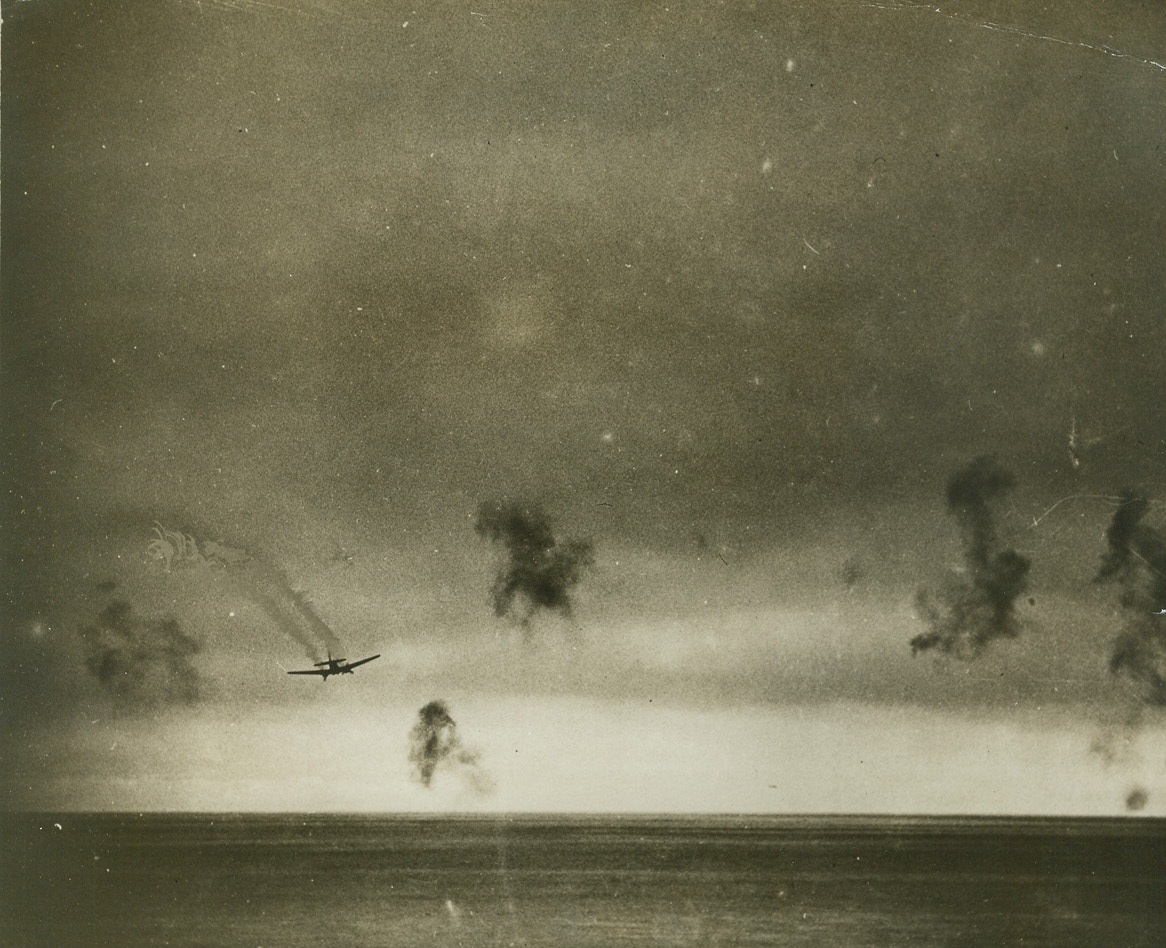
CONVOY ATTACK!, 7/25/1942. AT SEA—These pictures were made during one of the biggest convoy battles ever to take place on the Northern Trade Routes. The action took place early in July in the Barents Sea, when a United Nations convoy en route to Northern Russia was attacked by German torpedo planes, chiefly of the Heinkel III type. NEW YORK BUREAU Finis. This is the plane claim by a U.S. destroyer as one they are sure of. The pilot is heading out for his last sunset. Three other planes were hit. Credit: Acm;
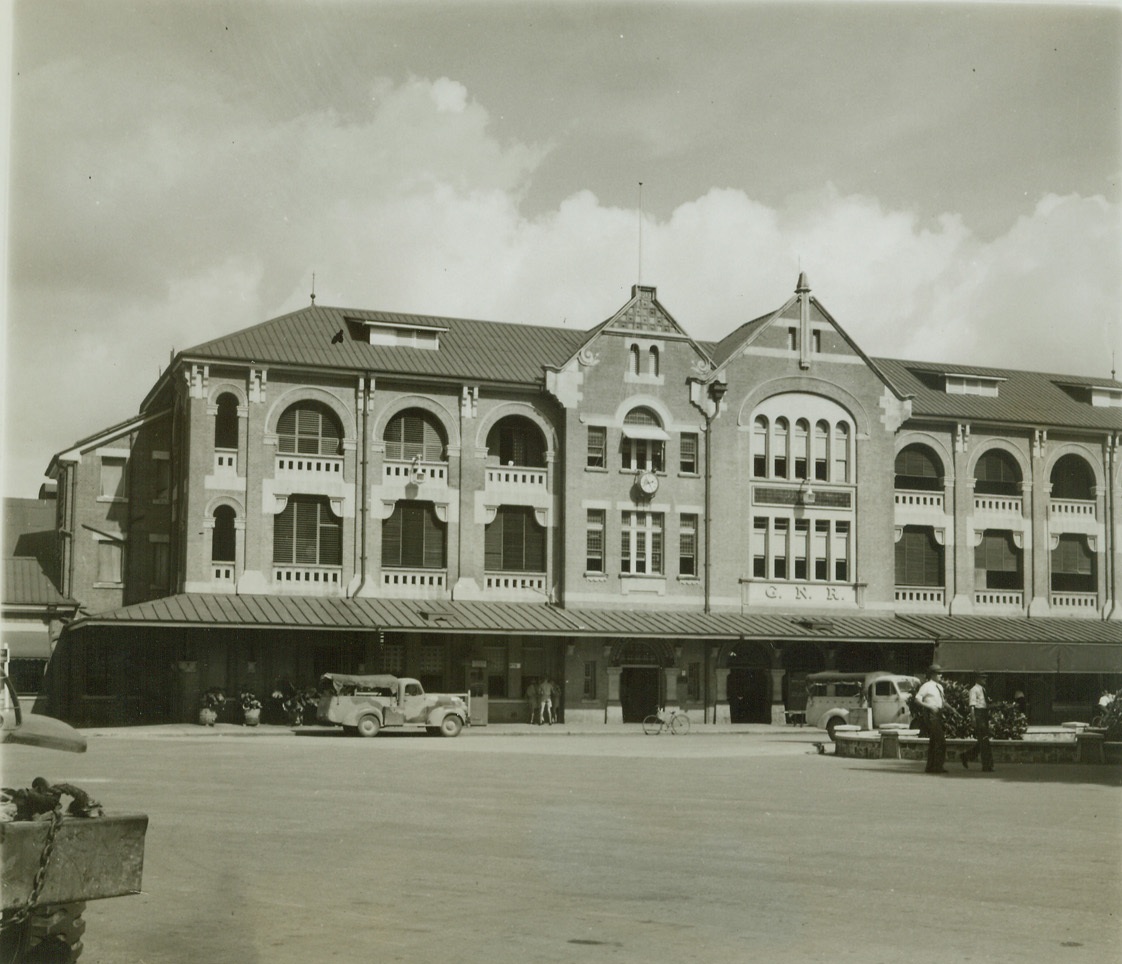
GETS TASTE OF FIRST AIR RAID, 7/26/1942. AUSTRALIA – View of the railway station at Townsville, strategic port and foundry town lying about midway between Sydney and the northern tip of Australia, which last night was raided by a small formation of Japanese flying boats. The raiders, who came in unescorted, dropped their bombs wide of their target and raced for home. It was the first raid on the continental shores of northeastern Australia. Credit: ACME;
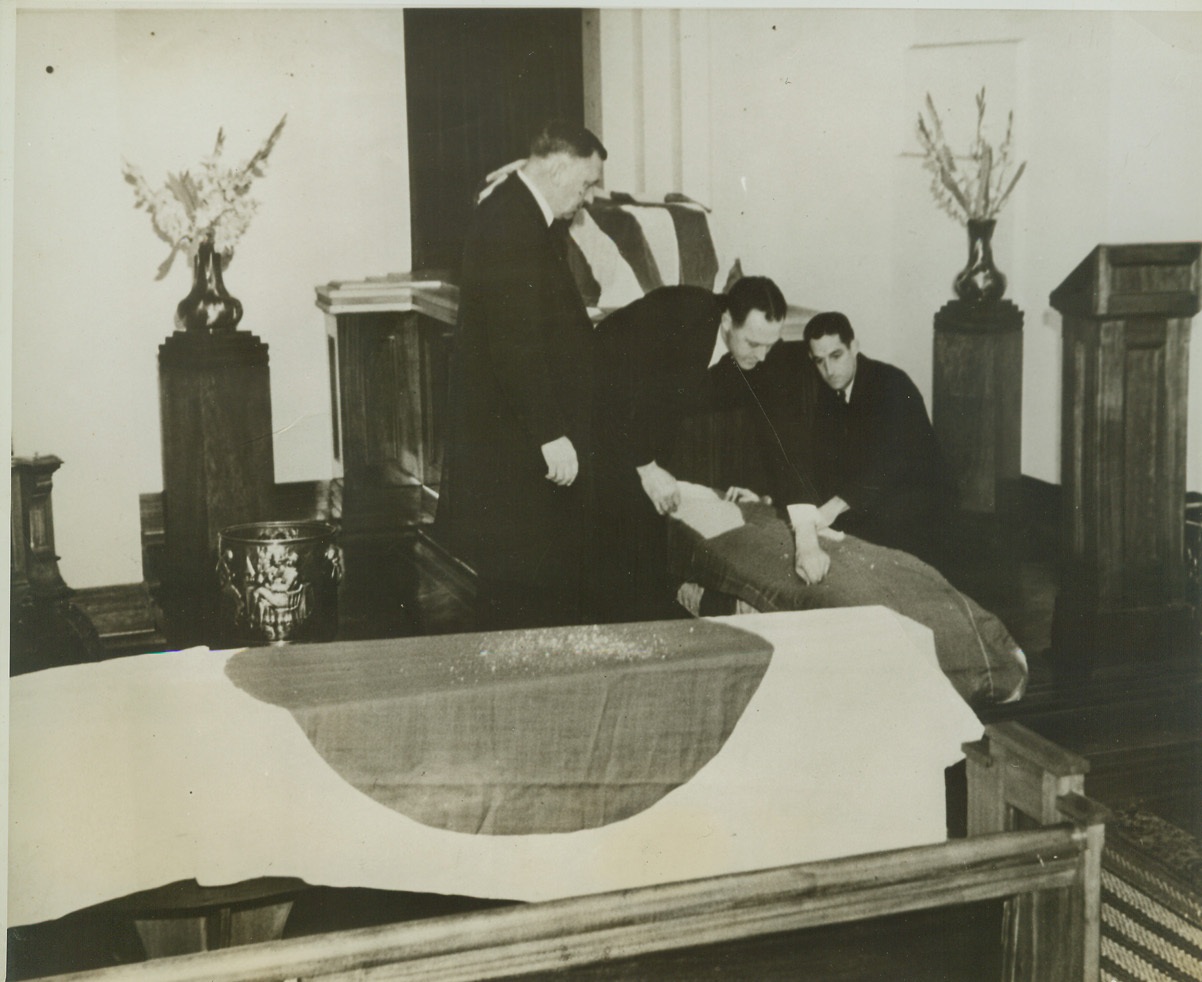
NAVAL HONORS ACCORDED JAPANESE, 7/26/1942. SYDNEY, AUSTRALIA – Coffins containing the bodies of four Japanese who lost their lives in a submarine attack on Sydney Harbor, May 31, are draped with the flag of their country as they lie in a chapel in Sydney. The dead sailors were accorded naval honors and their bodies cremated. Credit: ACME;
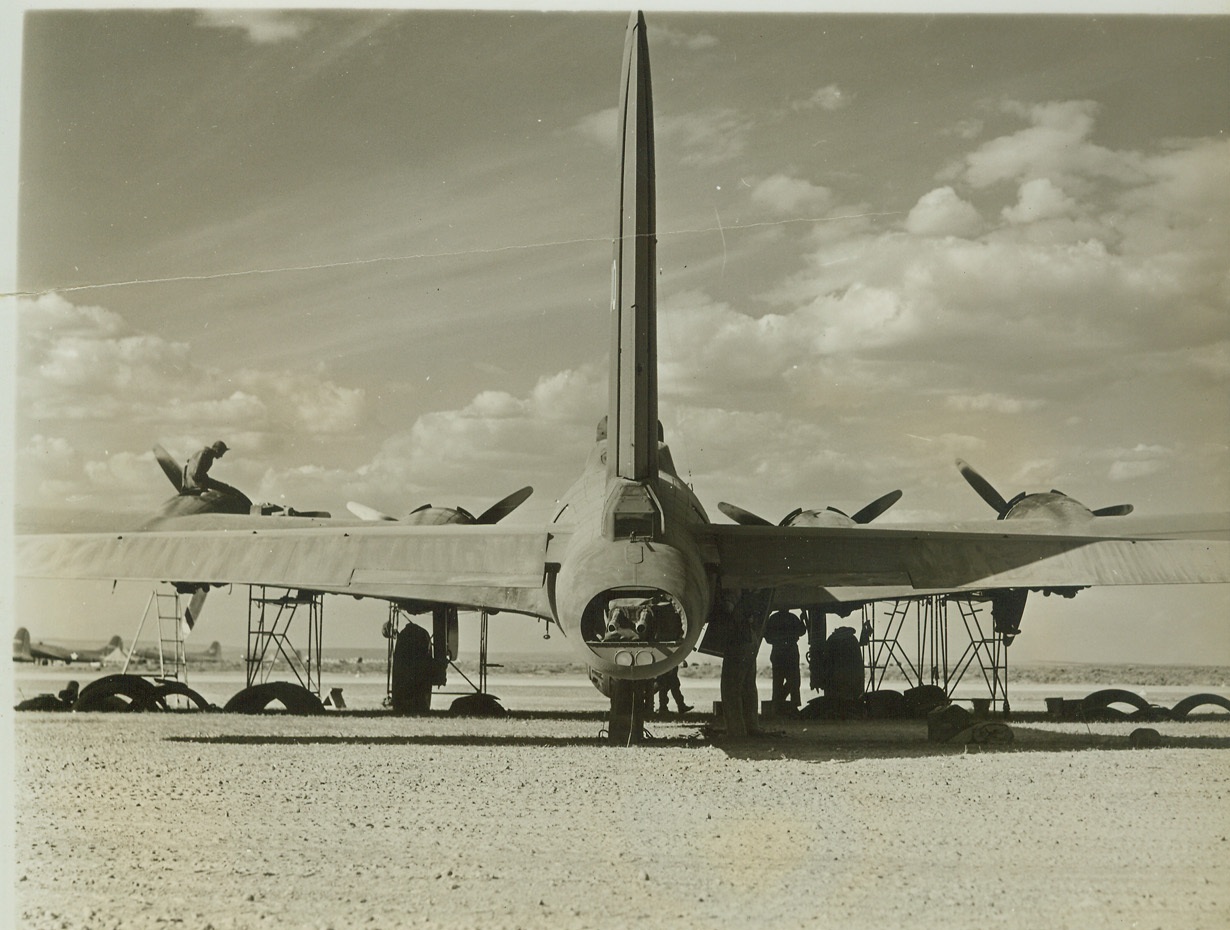
Stinger Close-Up, 7/26/1942. Here’s an unusual view of the tail end of a Boeing B-17F Flying Fortress, as mechanics check its four engines at an operational bombing base somewhere in the Northwest. the tail gun position is clearly seen. gunner sights through window just below rudder. Twin guns may be seen in extreme end of ship, with signal light below them. Credit: (ACME);
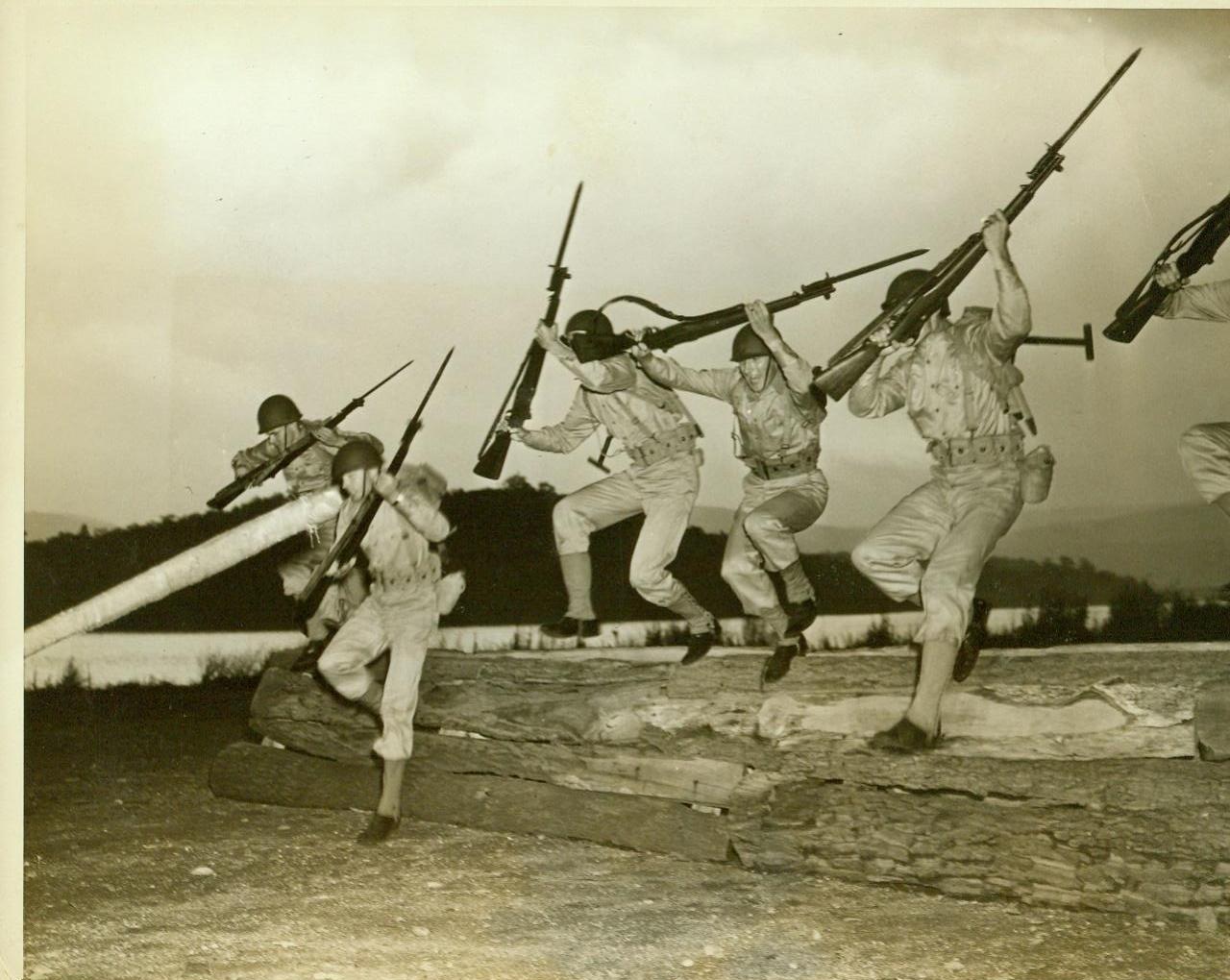
LARGEST WEST POINT CLASS “TOUGHENS UP”, 7/27/1942. WEST POINT, N.Y. – Twelve hundred plebes, the largest class ever to enter the United States Military Academy, answered their first reveille, July 27, and began an intensive course of “toughening up” that would keep the famous Commandos “stepping.” The first echelon of the class arrived July 1 and the remainder on July 15. With their preliminary training over, the plebes started on this new five-week course, which will precede academic work. In this series of photos, the plebes are shown as they were put through their paces the first day of the course. It’s “charge” and “charge hard” – The order of the day, as these plebes go over an assault wall after the “enemy.” Credit: ACME;
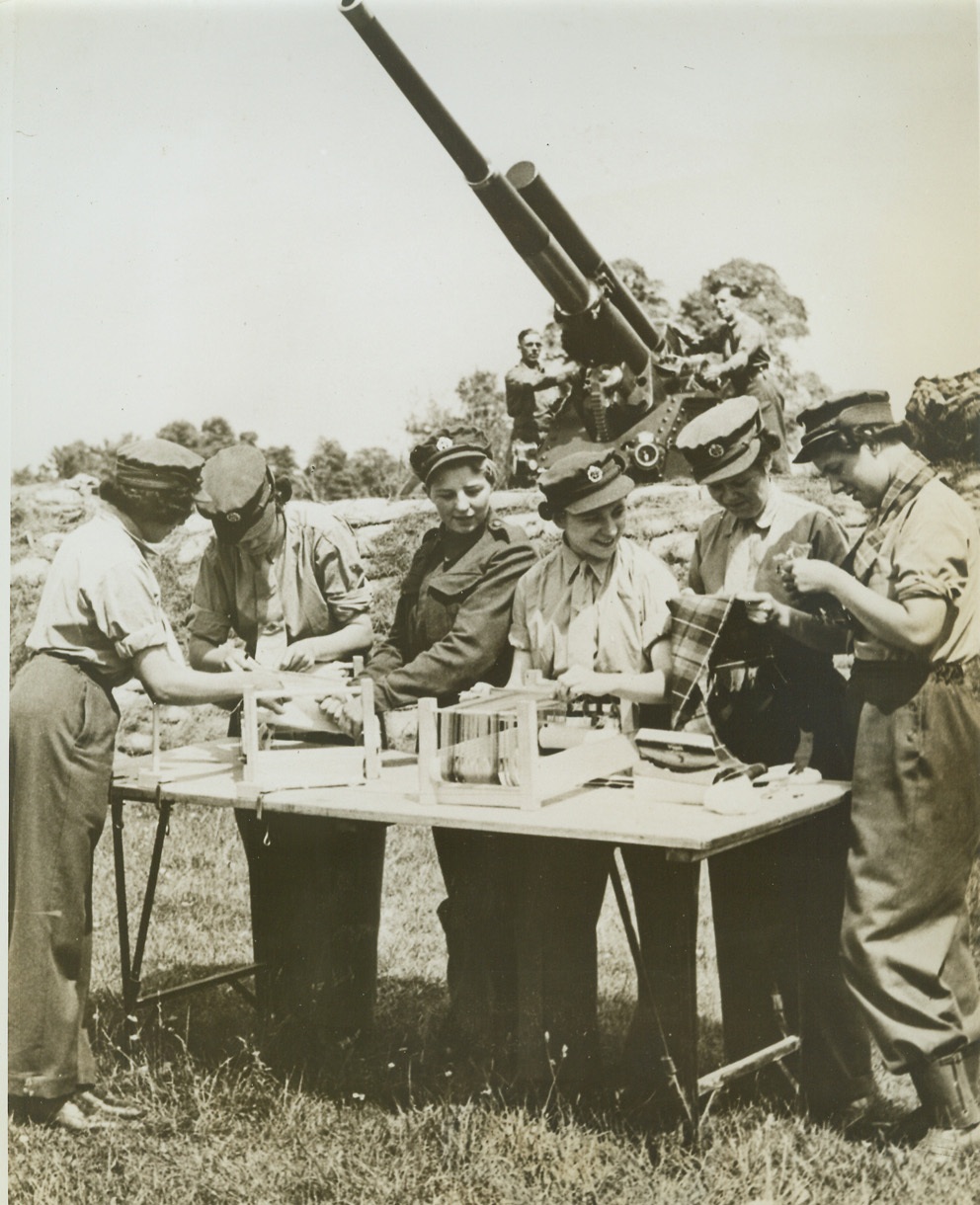
WEAVER GUNNERS, 7/28/1942. ENGLAND – In the shadow of their anti-aircraft gun, ATS girls of a mixed anti-aircraft battery in southwest England weave Scottish tartans. The girls are not Scots, and neither are their instructors, but their battery commander is, and in his honor the gunner-knitters chose the Fraser tartan for their first effort. (Passed by British censor). Credit: ACME;
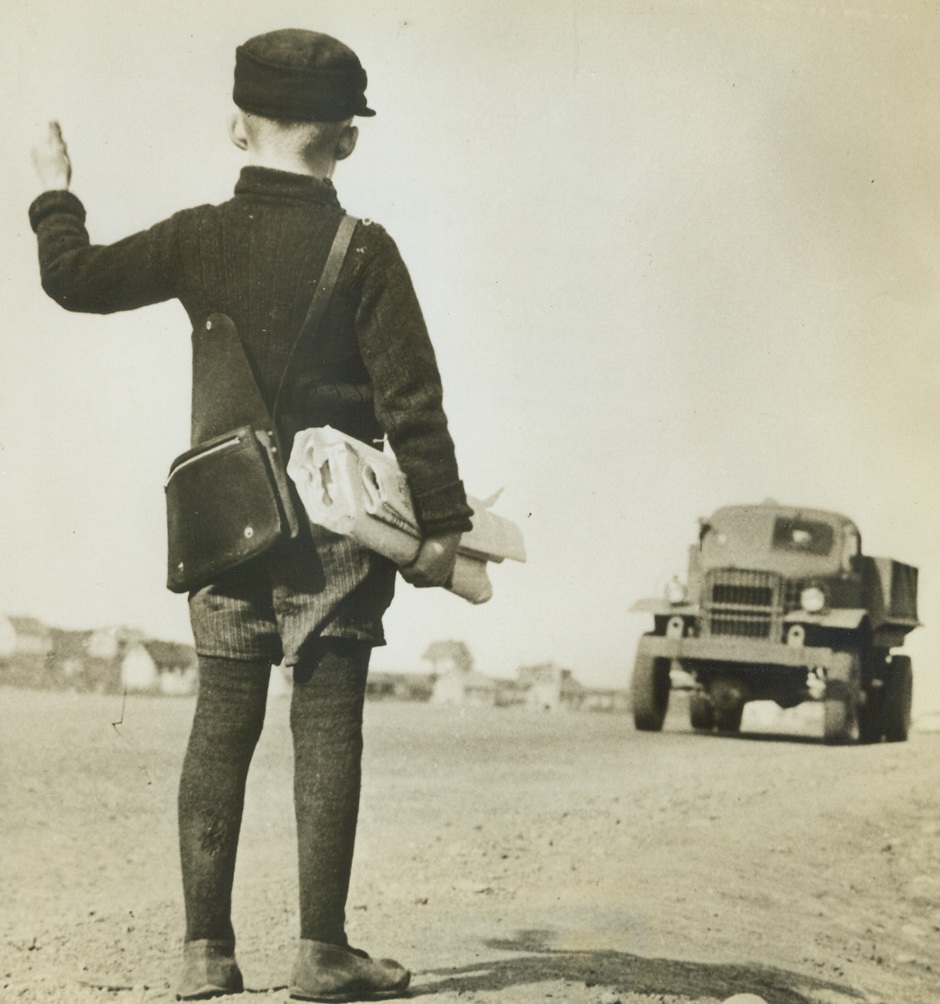
Hitch-Hiking in the Iceland Manner, 7/28/1942. Taking advantage of the opportunity offered by the sight of an approaching United States Army truck of our forces in Iceland, this young schoolboy uses the universal thumb method to hitch a ride to his school house. Credit Line (Official U.S. Army Photo from ACME);
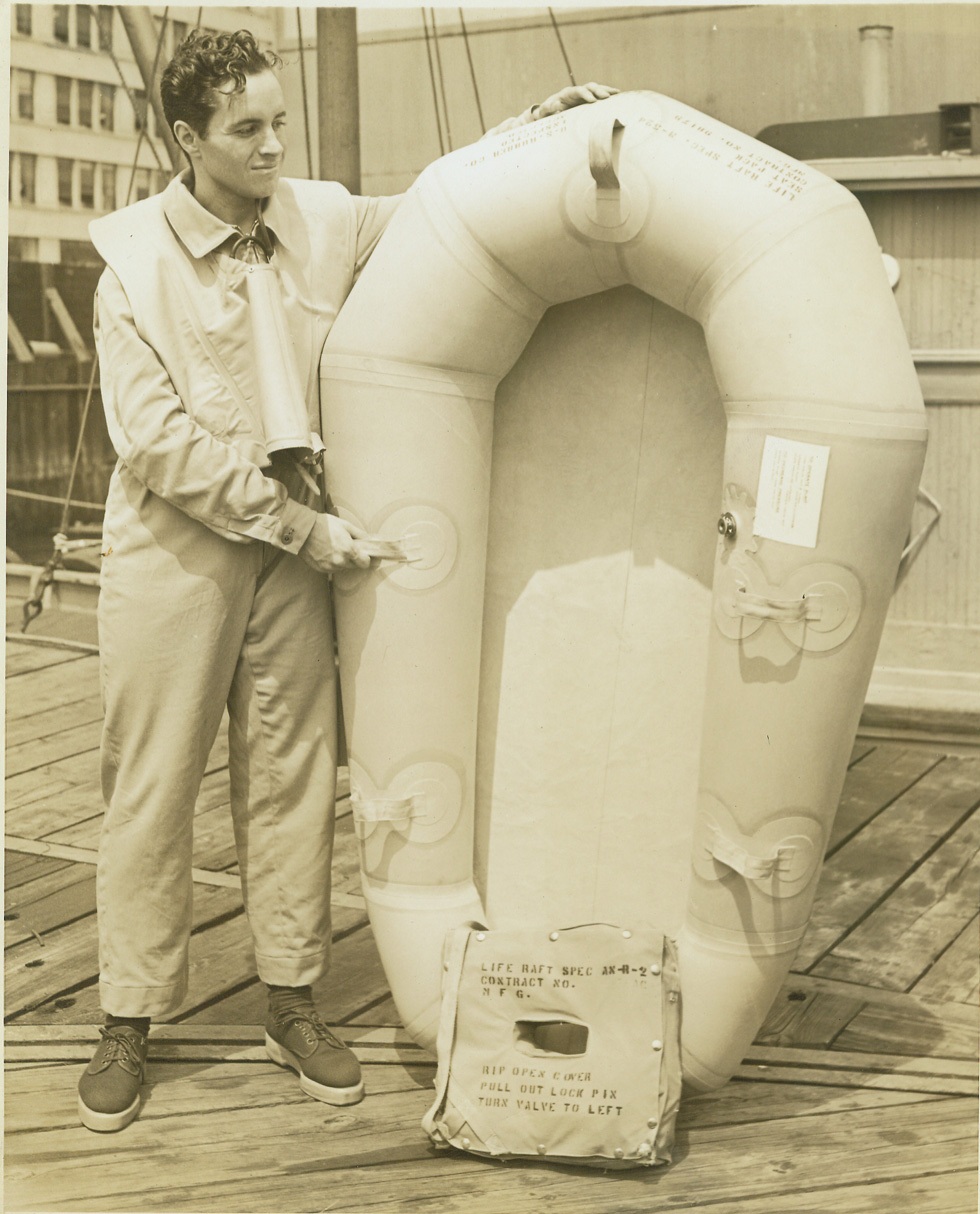
PARACHUTE BOAT FOR FIGHTER PILOTS, 7/30/1942. NEW YORK – An ingenious new one-man parachute boat, instantly inflatable, for emergency use on single-seater fighter planes is being produced by the U.S. Rubber Company. The total weight of this boat, including the eleven items of vital equipment that help protect the flier is only twelve pounds. It is attached to the pilot as a seat pack when he is in the plane. Ralph Douglas, who in a demonstration today jumped into the East River with a packed boat and in less than ten seconds had it inflated, shows a packed boat and a similar one inflated. Credit: OWI Radiophoto from ACME;

ONE-MAN PARACHUTE BOAT, 7/30/1942. NEW YORK – Ralph Douglas is shown in an ingenious new one-man parachute boat which the U.S. Rubber Company is producing for emergency use on single-seater fighter planes. It is attached to the pilot as a seat pack when he is in the plane. In a demonstration today, Douglas jumped into the East River with the packed boat and in less than ten seconds had it inflated. The two wire reinforced fabric paddles he is using to propel and steer the boat are among the eleven items of vital equipment in the pack, which weighs only twelve pounds. Credit: OWI Radiophoto from ACME;

SWORN IN AS W.A.A.C. BAND MEMBER, 7/30/1942. NEW YORK, NY – Miss Janet Rose Montgomery, 29, blows a tune on her horn after being sworn in as one of the first members of the W.A.A.C. Military Band, at the Headquarters of the Southern New York Recruiting and Induction District, 39 Whitehall Street. Miss Montgomery who is from Detroit, Mich., has had considerable experience with bands in the Middle West. She will report to Ft. Des Moines, Iowa, August 3rd. Credit: ACME;

Retreat From Burma, 7/30/1942. On one of the most dramatic journeys recorded in the annals of the war, so far, Lt. Gen. Joseph W. Stillwell, at the head of a band of 114 Americans, Burmese nurses, Chinese, Indians, Britons and Anglo-Indians, covered 140 grueling miles on their retreat from Wuntho, Burma, which began on May 4th, 1942. For days the band struggled through the torturous heat of the dense malaria-infested swamps and jungles of Burma, to reach the banks of the Uyu River, where they were forced to abandon the few Jeeps and trucks they had, to proceed on home-made rafts, down the river to the Chindwin and Thenge to Imphal on the Indian frontier. They arrived at their destination, Dinjan, India with only a few cases of malaria and heat exhaustion. Considering what they had been through, their journey was remarkably successful. Here, in a series of 25 official U.S. Army photos, just arrived from India, the story of the retreat is graphically presented. New York Bureau This bridge was repaired by the Chinese on time, and Major General Franklin C. Sibert, starts ahead of the first Jeep in the column. Credit: (U.S. Army Photo from ACME);
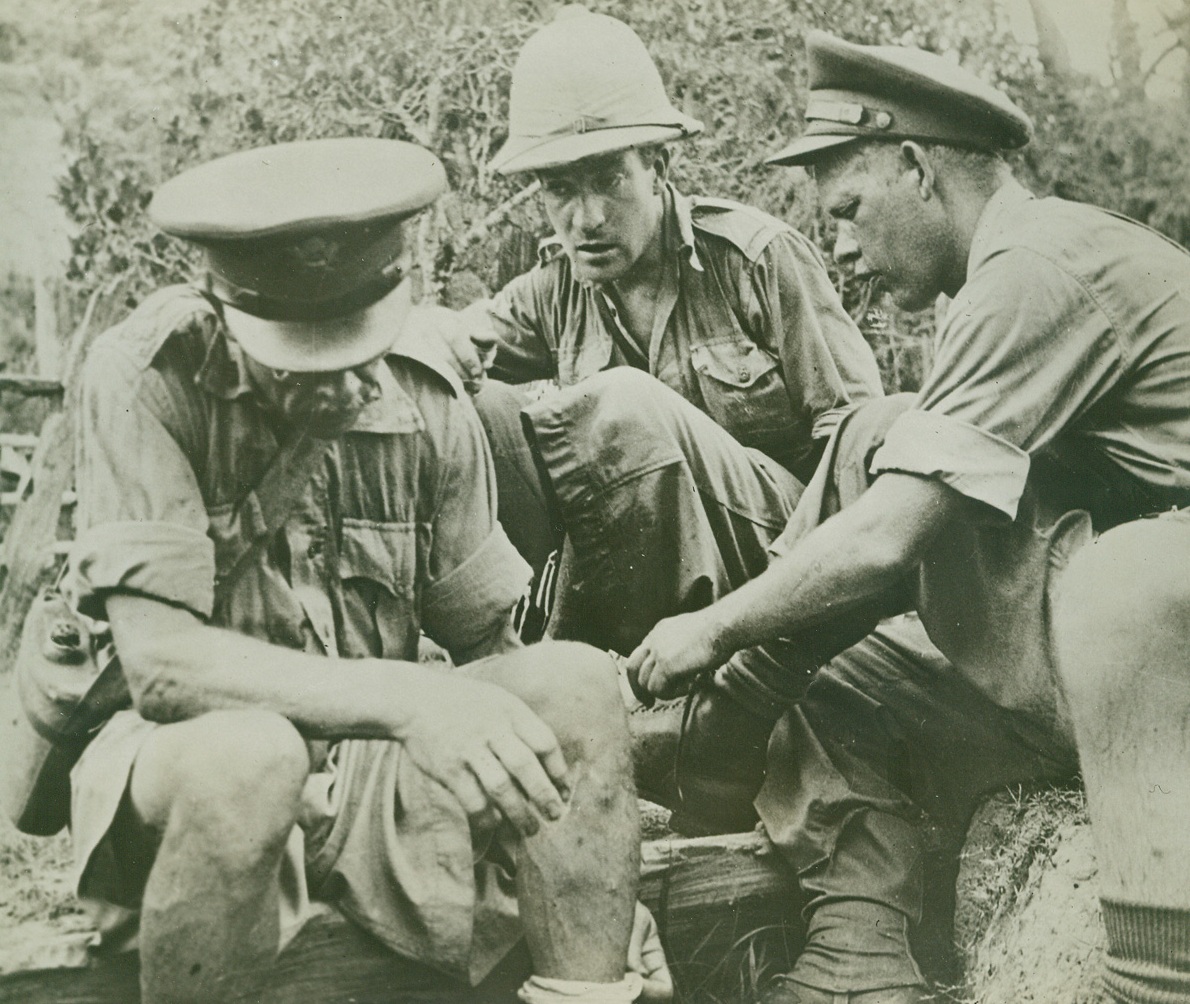
Retreat from Burma, 7/30/1942. On one of the most dramatic journeys recorded in the animals of the war, so far, Lt. Gen. Joseph W. Stillwell, at the head of a band of 114 Americans, Burmese nurses, Chinese, Indians, Britons and Anglo-Indians, covered 140 grueling miles on their retreat from Wuntho, Burma, which began on May 4th, 1942. For days the band struggled through the torturous heat of the dense Malaria-infested swamps and jungles of Burma, to reach the banks of the Uyu river, where they were forced to abandon the few jeeps and trucks they had. To proceed on home-made rafts, down the river to the Chindwin and thence to Imphal on the Indian frontier. They arrived at their destination, Dinjan, India, with only a few cases of Malaria and heat exhaustion. Considering what they had been through, their journey was remarkably successful. Here, in a series of 25 official U.S. Army photos, just arrived from India, the story of the retreat is graphically presented. New York Bureau Maj. Gordon S. Seagrave (left), Capt. J.H. Grindlay, (right), and a member of the Friends Ambulance Unit from Burma try to comfort their feet on a rest stop.;
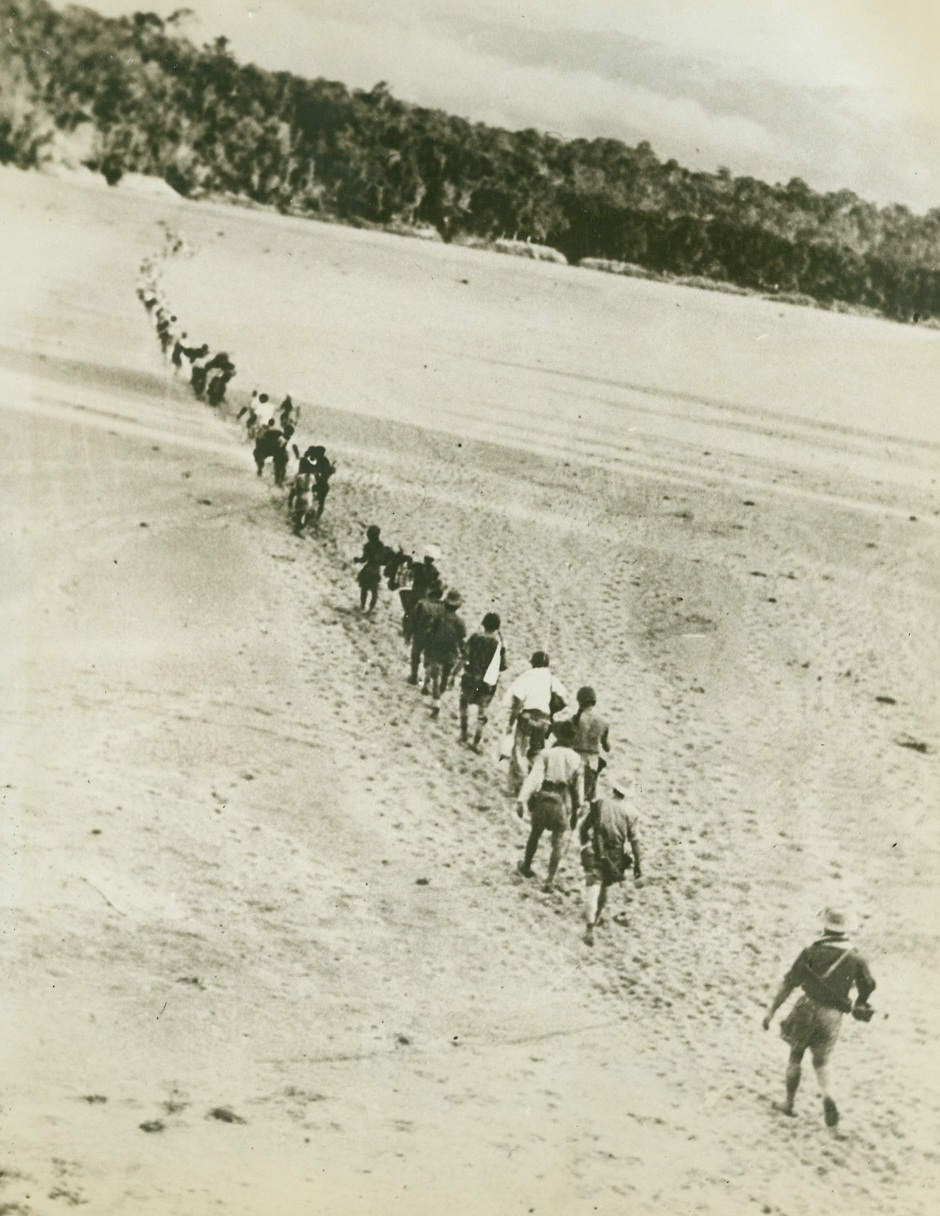
No Title, 7/30/1942. On one of the most dramatic journeys recorded in the annals of the war, so far, Lt. Gen. Joseph W. Stillwell, at the head of a band of 114 Americans, Burmese nurses, Chinese, Indians, Britons and Anglo-Indians, covered 140 grueling miles on their retreat from Wuntho, Burma, which began on May 4th, 1942. For days the band struggled through the torturous heat of the dense Malaria-infested swamps and jungles of Burma, where they were forced to abandon the few jeeps and trucks they had, to proceed on home-made rafts, down the river to the Chindwin and thence to Imphal on the Indian frontier. They arrived at their destination, Dinjan, India, with only a few cases of Malaria and heat-exhaustion. Considering what they had been through, their journey was remarkably successful. Here, in a series of official U.S. Army photos, just arrived from India, the story of the retreat is graphically presented.New York BureauHere, the party has finally reached the Chindwin river, and walks across the long stretch of land leading to the river’s edge.Credit Line (U.S. Army photo from ACME);

Retreat from Burma, 7/30/1942. On one of the most dramatic journeys recorded in the annals of the war, so far, Lt. Gen. Joseph W. Stillwell, at the head of a band of 114 Americans, Burmese nurses, Chinese, Indians, Britons and Anglo-Indians, covered 140 grueling miles on their retreat from Wuntho, Burma, which began on May 4th, 1942. For days the band struggled through the torturous heat of the dense Malaria-infested swamps and jungles of Burma, to reach the banks to the Uyu river, where they were forced to abandon the few jeeps and trucks they had, to proceed on home-made rafts, down the river to the Chindwin and thence to Imphal on the Indian frontier. They arrived at their destination, Dinjan, India, with only a few cases of Malaria and heat exhaustion. Considering whatt they had been through, their journey was remarkably successful. Here, in a series of 25 official U.S. Army photos, just arrived from India, the story of the retreat is dramatically presented.New York BureauCol. George W. Stillwell, (left), Lt. Col. Frank Morrill (center), and Maj. Felix Nowakowski bathe their feet in a little stream in Burma.Credit Line (U.S. Army photo from ACME);
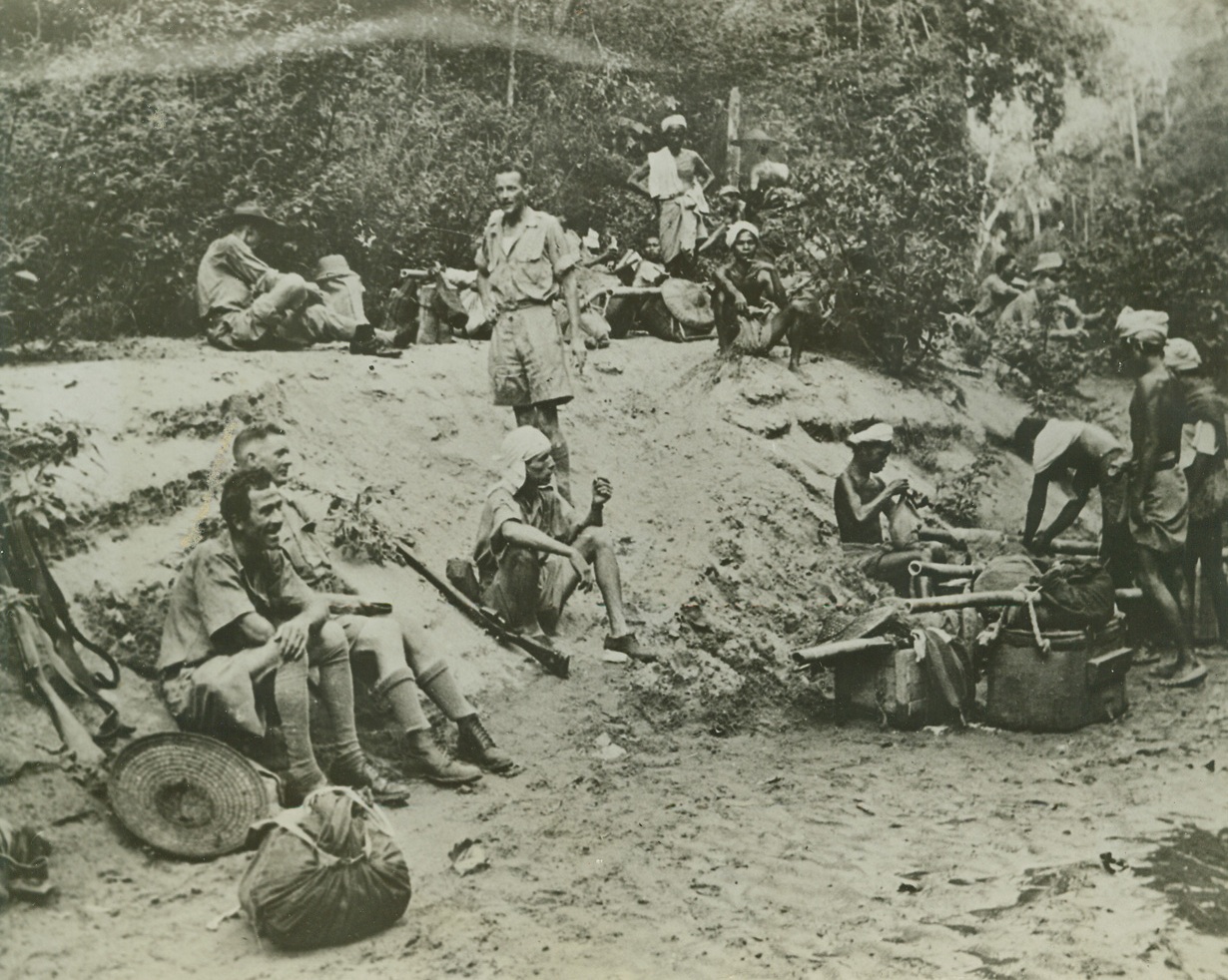
Retreat from Burma, 7/30/1942. On one of the most dramatic journeys recorded in the annals of the war, so far, Lt. Gen. Joseph W. Stillwell, at the head of a band of 114 Americans, Burmese nurses, Chinese, Indians, Britons and Anglo-Indians, covered 140 grueling miles on their retreat from Wuntho, Burma, which began on May 4th, 1942. For days the band struggled through the torturous heat of the dense Malaria-infested swamps and jungles of Burma to reach the banks of the Uyu river, where they were forced to abandon the few jeeps and trucks they had, to proceed on home-made rafts, down the river to the Chindwin and thence to Imphal on the Indian frontier. They arrived at their destination, Dinjan, India, with only a few cases of Malaria and heat exhaustion. Considering what they had been through, their journey was remarkably successful. Here, in a series of 25 official U.S. Army photos, just arrived from India, the story of the retreat is graphically presented.New York BureauGen. Stillwell permitted ten minutes rest during each hour of the march, which averaged between 15 and 22 miles per day. Here, the group is shown resting during one of those periods.Credit Line (U.S. Army photo from ACME);
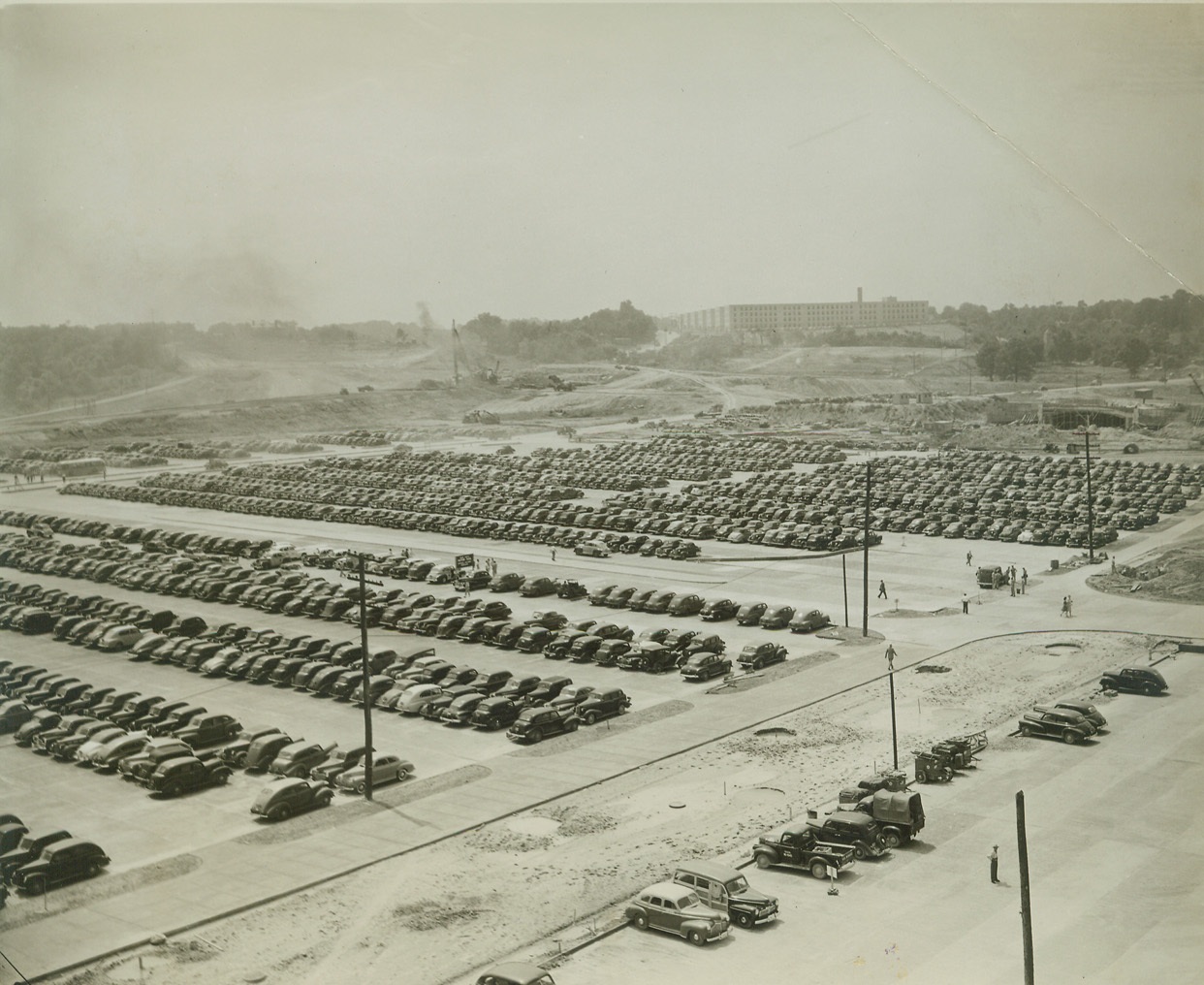
War Department Workers Jam Parking Space, 7/30/1942. WASHINGTON, D.C. – Although the new War Department pentagon building is not fully occupied, thousands of automobiles jam the parking space adjacent to the new building. The field is especially laid out to accommodate workers in the new building. Credit: (ACME);

One of the most unusual photos, 7/30/1942. One of the most unusual photos in military history, it shows Lt. Gen. Joseph W. Stilwell, clad in underware, wearing a campaign hat, and with cigarette holder cocked at a jaunty angle, wading out to a raft with a sack of bully-beef over his shoulder. A RAF Blenheim bomber has just dropped food to the column, and the General is doing his share of the carrying. Credit: U.S. Army photo from ACME.;
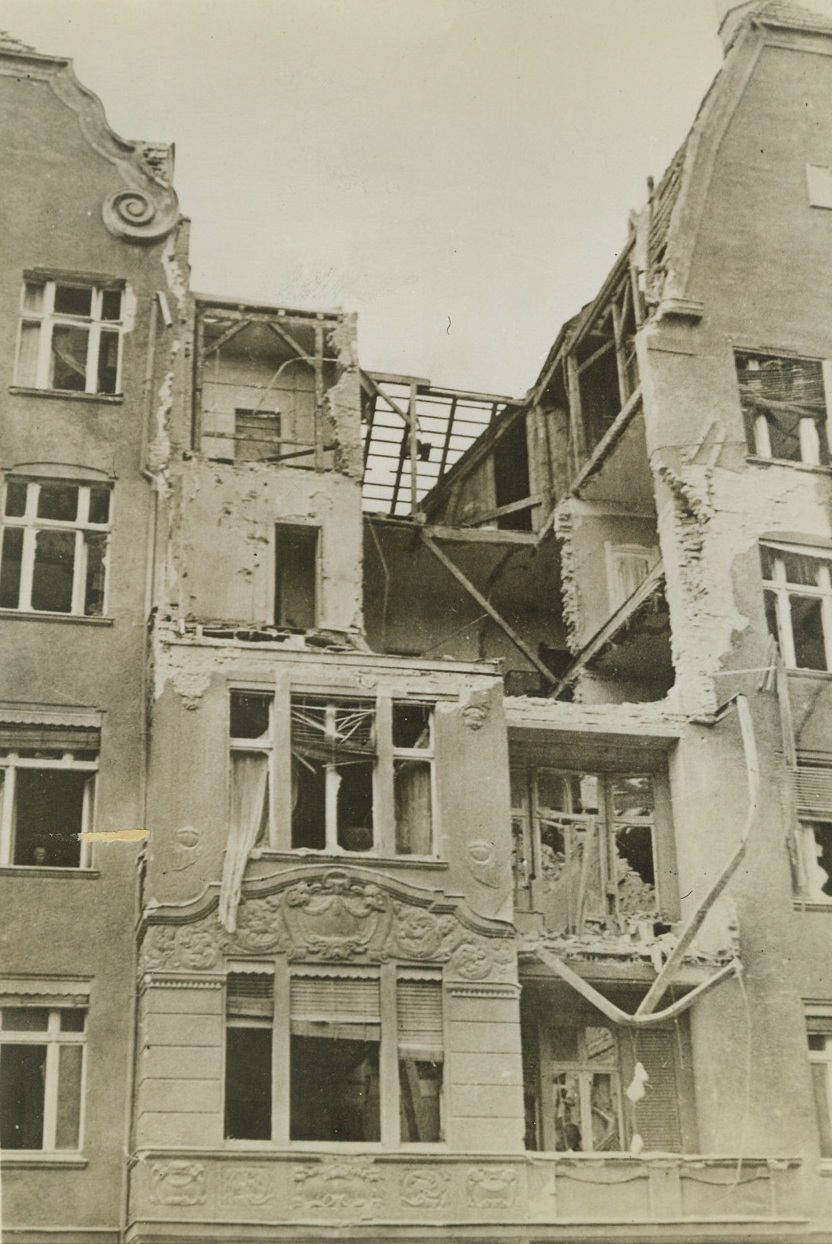
Berlin After Bombing, 7/7/1942. BERLIN, GERMANY – Here is a bomb hit on a building on Meineke Strasse, Berlin, next to the headquarters of the capital’s Anti-Air Raid Division No. 1. If ever the RAF carries out one of its 1,000-plane raids over the city, scenes like this one will be seen throughout Berlin. Credit Line (ACME);
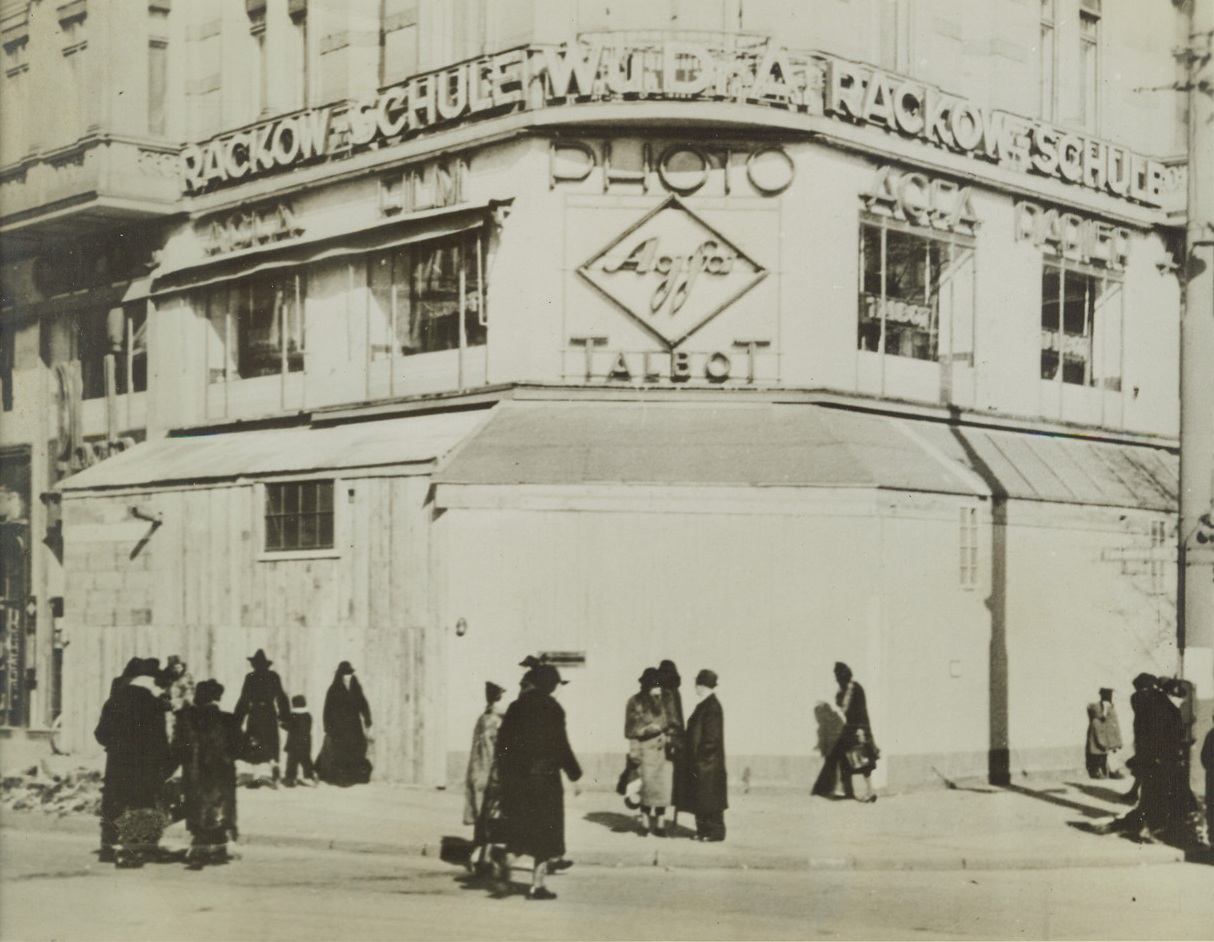
Berlin Prepares—for Trouble at Home, 7/7/1942. BERLIN, GERMANY – This former store of the Singer Sewing Machine Company on Wittenberg Platz, Berlin, is supposed to be an “SS” (Elite Guard) air raid shelter. Actually it is a pillbox, which, in case of demonstrations, could cover the square and the nearby subway station with its machine guns.Credit: (ACME);
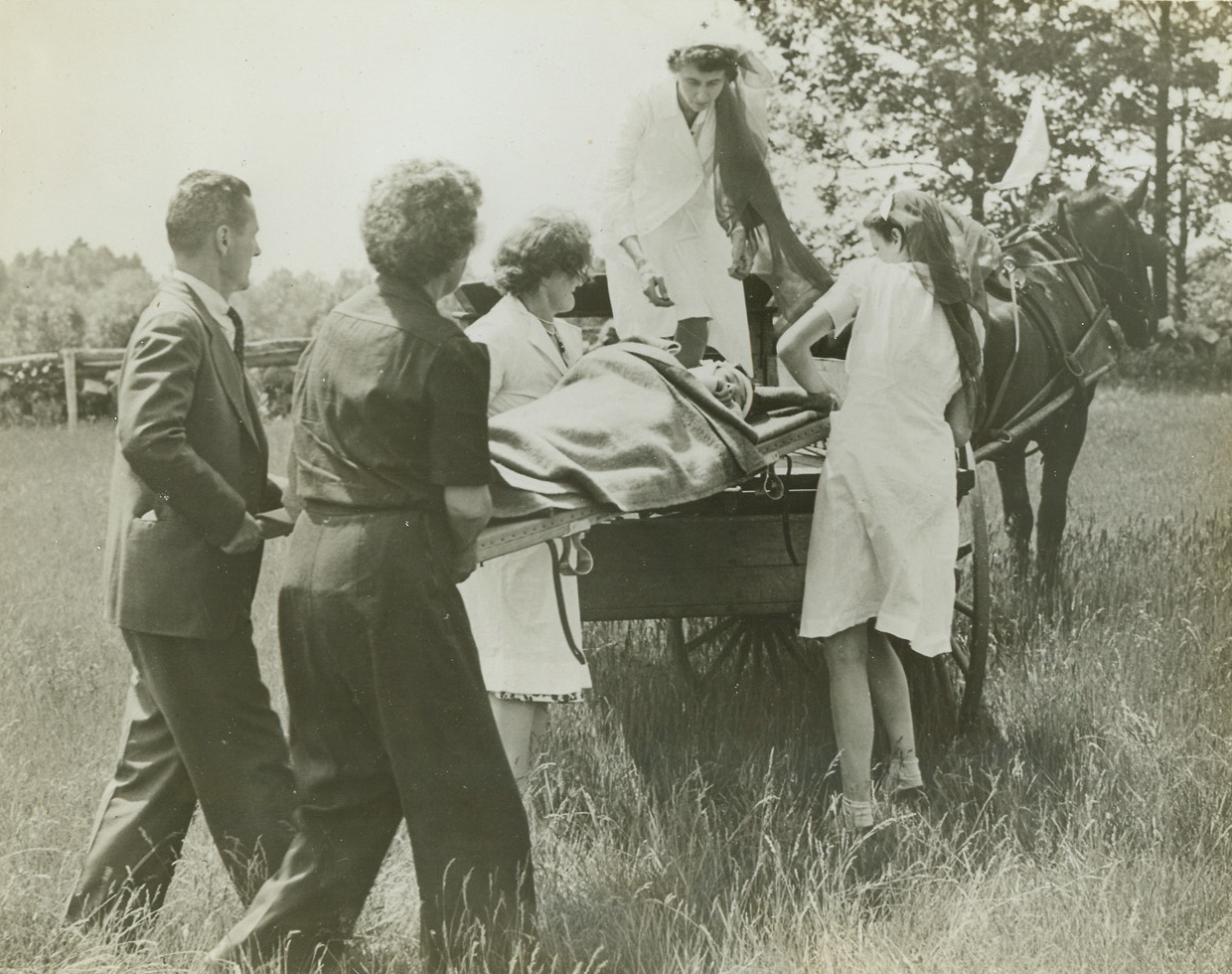
Ready for Gasless Emergency, 7/28/1942. Boston, Mass.—This Red Cross unit is preparing for wartime emergency, using “Dobbin” and a wagon instead of gasoline-burning ambulances for their first aid practice. The group is from the Volunteer Motor Corps of the Medfield Branch of the Boston Red Cross Chapter, and they have organized a “horse corps” composed entirely of horse-drawn vehicles.Credit: ACME.;

Retreat from Burma, 7/30/1942. On one of the most dramatic journeys recorded in the annals of the war, so far, Lt. Gen. Joseph W. Stillwell, at the head of a band of 114 Americans, Burmese nurses, Chinese, Indians, Britons and Anglo-Indians, covered 140 grueling miles on their retreat from Wuntho, Burma, which began on May 4th, 1942. For days the band struggled through the torturous heat of the dense malaria-infested swamps and jungles of Burma, to reach the banks of Uyu River, where they were forced to abandon the few jeeps and trucks they had, to proceed on home-made rafts, down the river to the Chindwin and thence to Imphal on the Indian frontier. They arrived at their destination, Dinjan, India, with only a few cases of malaria and heat exhaustion. Considering what they had been through, their journey was remarkably successful. Here, in a series of 25 official U.S. Army photos, just arrived from India, the story of the retreat is dramatically presented. New York Bureau Soldiers and Burmese nurses cross the Chindwin River in dug-outs. Credit: U.S. Army Photo from ACM;

Berlin Under Camouflage, 7/7/1942. Berlin, Germany – The Nazis have undertaken extensive camouflage operations throughout the city to fool crack RAF Bombardiers. Here is a view of the camouflaged exposition halls on Kaiserdamm in Berlin. 7/7/42 (ACME);
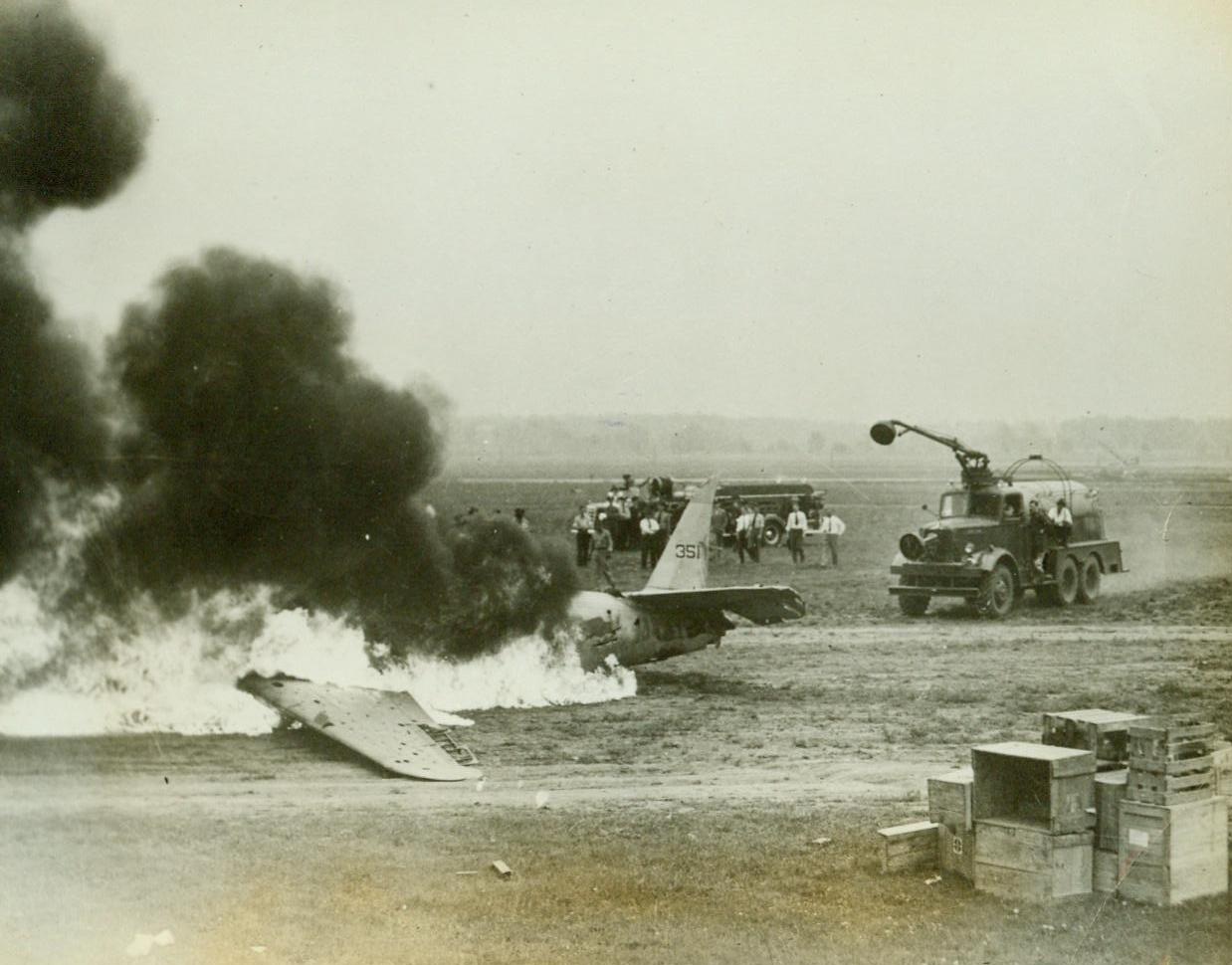
New Air Force Crash Truck, 7/24/1942.
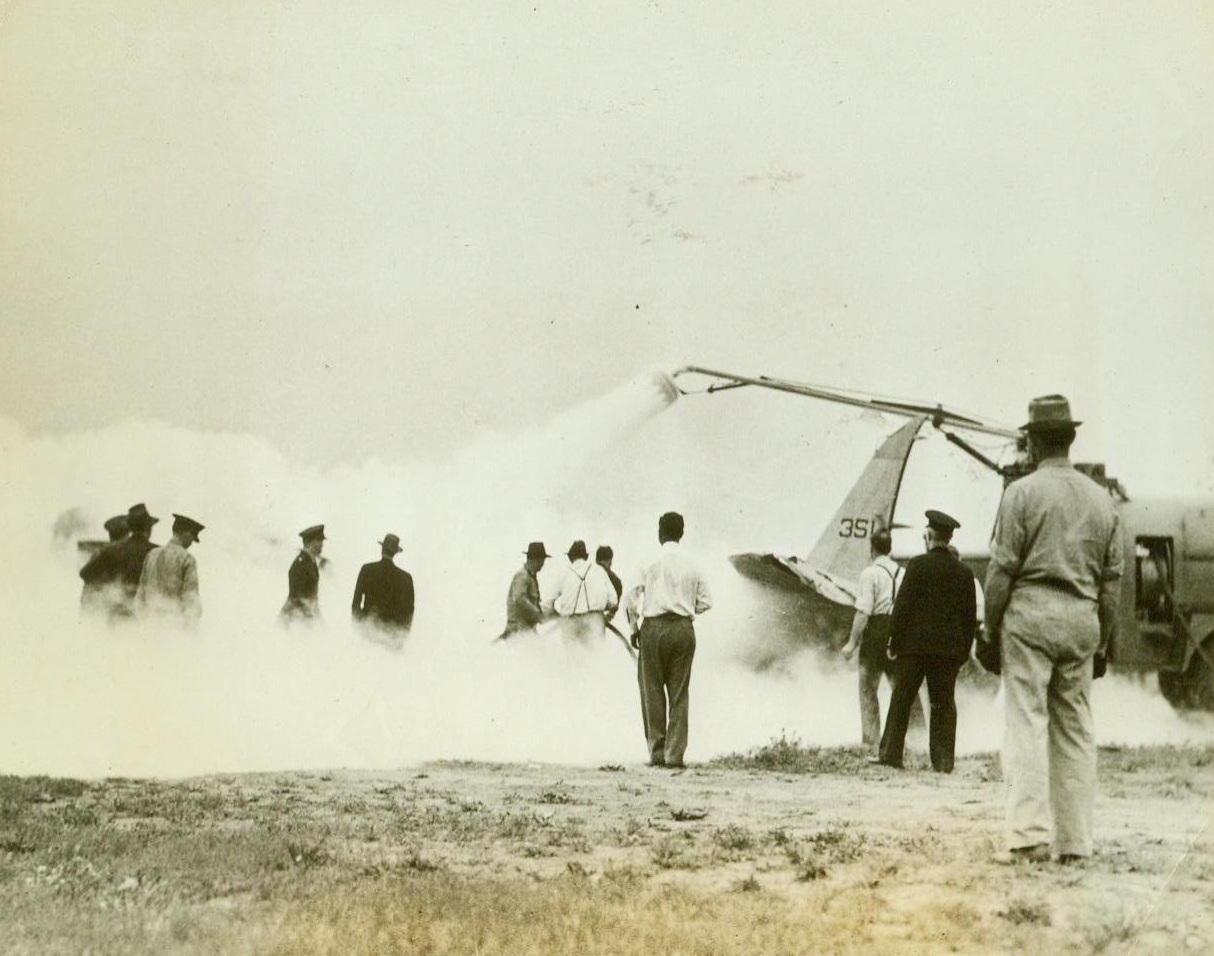
New Air Force Crash Truck, 7/24/1942. Research activities at a U.S. flying field have developed a new life saving device – a fire fighting crash truck, designed to save the lives of men in our Air Force. The truck which can smother a fire by throwing thousands of pounds of Carbon Dioxide on a burning plane in 3 minutes, proved to be a success after being tested. Photo shows the crash truck, not only driving back the flames, but cooling the hot metal to allow rescue of the occupants. 7/24/42 (ACME);
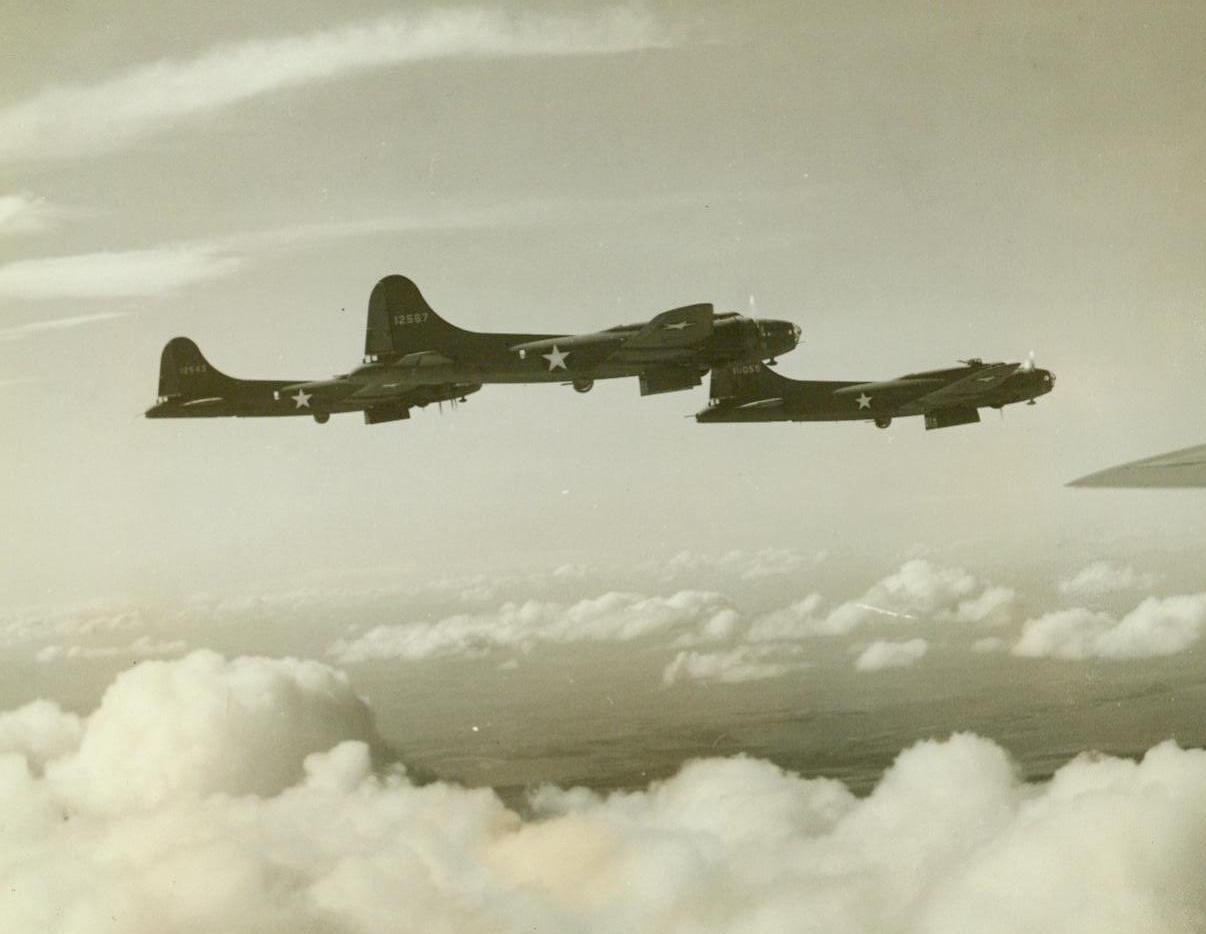
Objective Ahead, 7/26/1942. When the bombardier of a Boeing flying fortress sights the target, he swings open the bomb bay doors. This formation, walking its way over fleedy clouds on a practice run at an operational bombing base somewhere in the Northwest, is ready for business 7/26/42 (ACME);
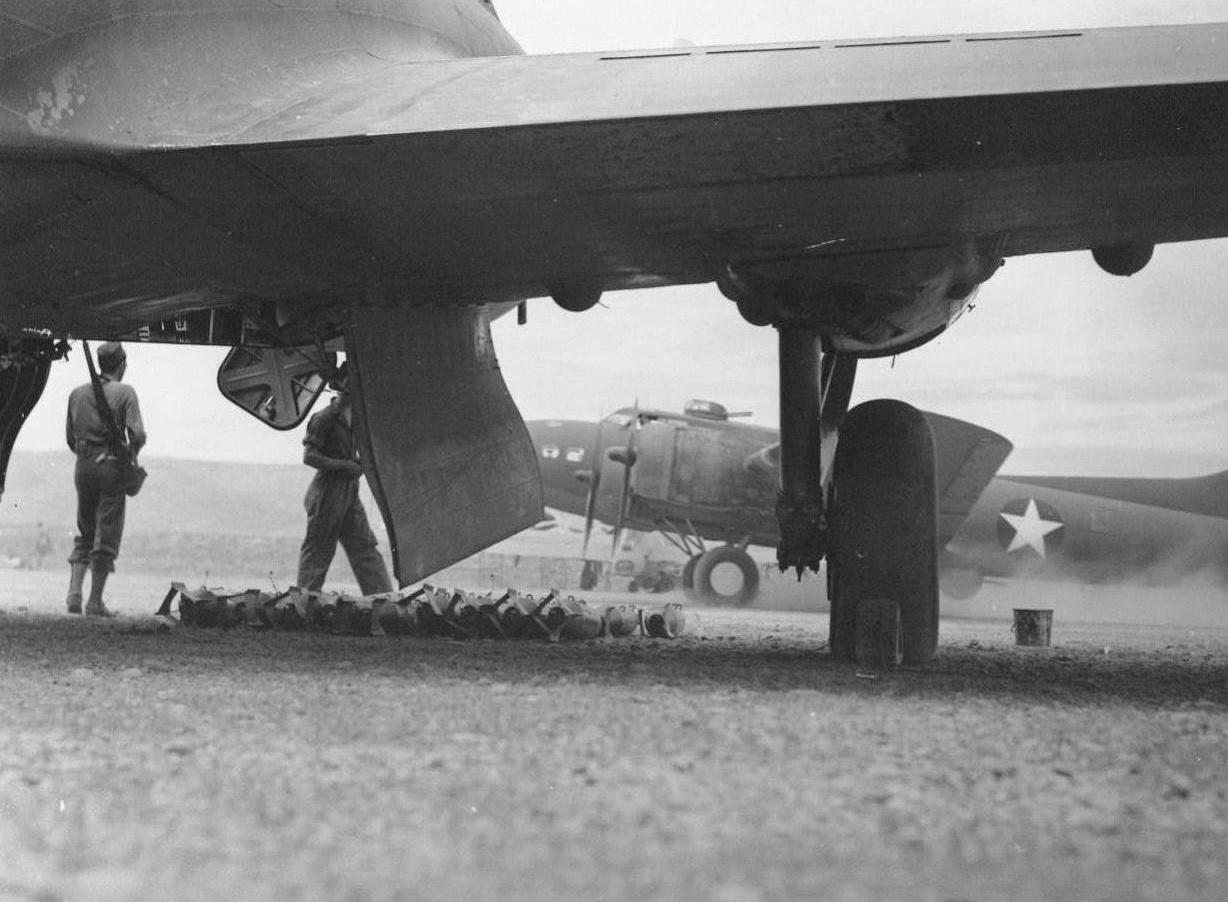
Ready To Load, 7/26/1942. In neat rows, a load of 100 pound practice bombs are ready for the bomb racks inside a B-17 flying fortress at an operational bombing base somewhere in the Northwest. Note the huge bomb bay doors swung open. In the distance a loaded plane, starting a take-off run, kicks up quite a sandstorm. To bases like this, bomber units, formed at regular Army airfields throughout the country are sent for a month’s final training before hopping off for the fighting front 7/26/42 (ACME);





 Trash & Recycling
Trash & Recycling
 Online Payments
Online Payments
 City Documents
City Documents
 Parks
Parks
 Traffic Court
Traffic Court
 CITY PARKS
CITY PARKS
 Outdoor Recreation
Outdoor Recreation
 Volunteer
Volunteer
 Home
Home TRANSLATE
TRANSLATE
